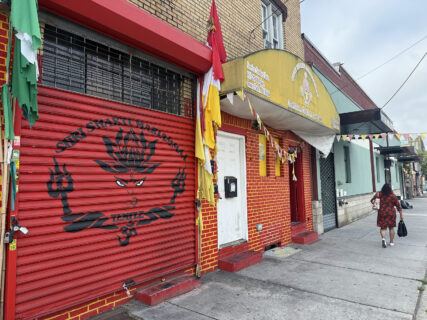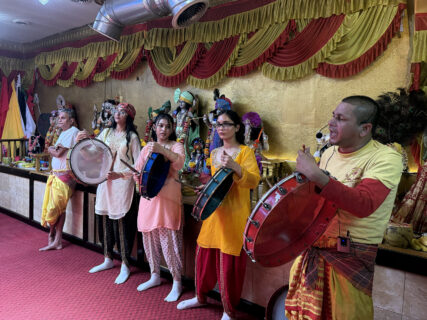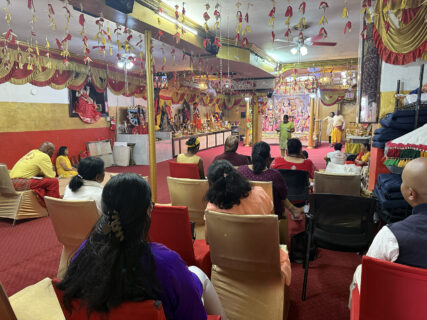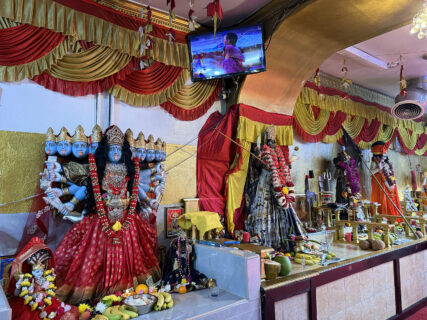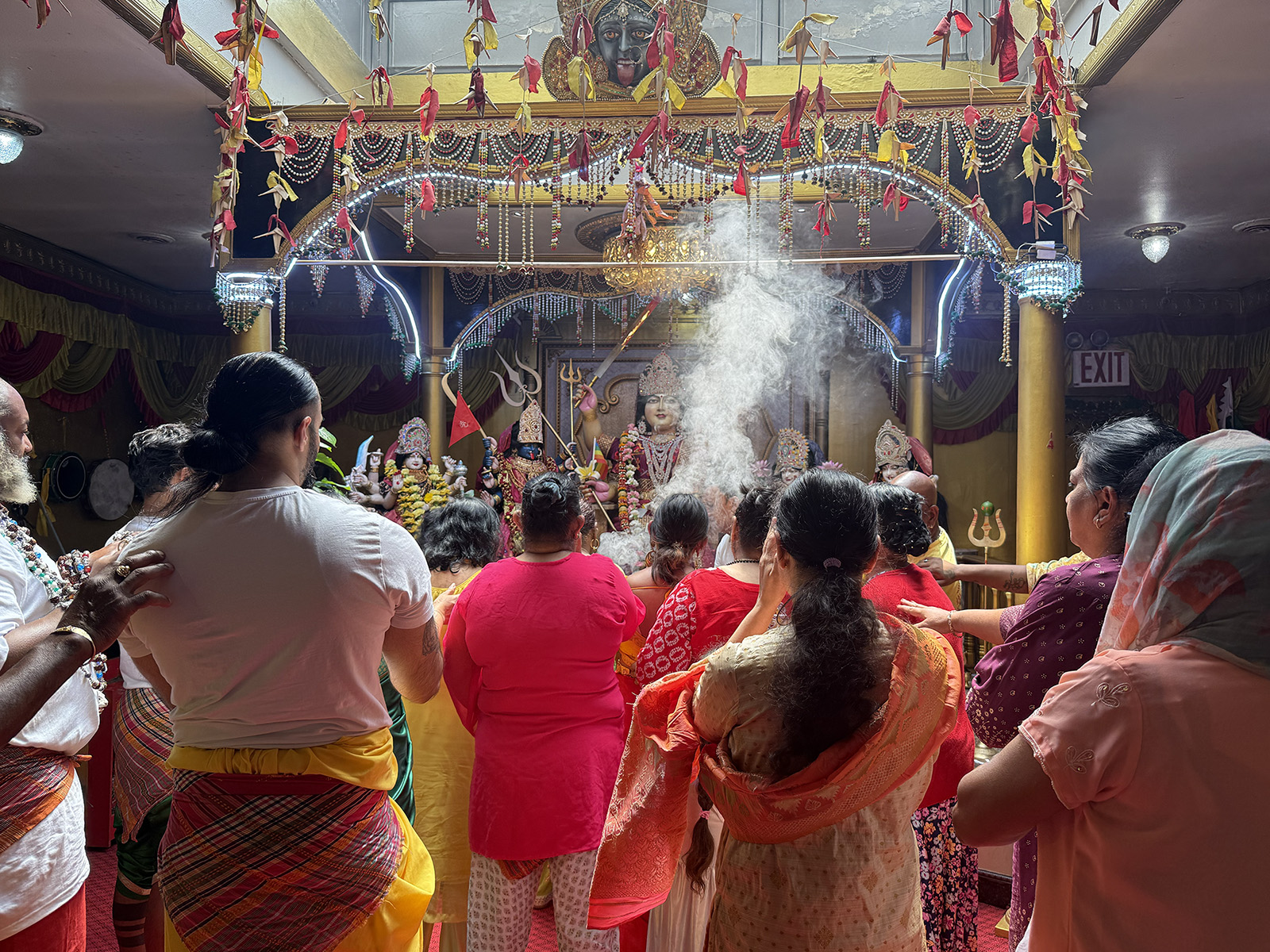
NEW YORK (RNS) — Illuminated by a skylight at the center of a small factory-turned-Hindu temple in Queens sits a murti of the Divine Mother — a 1-ton, 6-foot-tall icon of the South Indian village goddess Mariamman, an incarnation of Kali, the deity of time and death. Smoke from cigarettes and incense fills the room, and bottles of rum sit next to fruit at the altar.
“Our religion is very rural, very villagelike,” said Chandni Kalu, 31, a priestess at the Richmond Hill temple. “It’s very raw.”
Even other Hindus might find Sunday worship services at the Shri Shakti Mariammaa temple unfamiliar. The mostly Indo-Caribbean congregants worship goddess Kali, who also represents transcendental knowledge that can manifest within, or spiritually possess, her followers. At a recent service, a young male pujari, or lay priest, shook and danced vigorously through the crowd, entranced with Shakti, the feminine energy that inhabits someone possessed by Kali.
“We are a healing temple,” said Sharda Ramsami, one of the original members of the temple when it was founded in 2008. “Whether it’s something physical or something spiritual, we are always the last resort, and when people come here, they’re desperate for help. I think that’s what’s most powerful: that desperation, and then here’s the answer that no one else could provide for them. Mother knows.”
But the temple is also known as one that is open to all. Its clergy have married same-sex couples after they were shunned or rejected from other Hindu temples in the area, and, uniquely, those clergy, the temple staff and congregants are mostly women. Women come to seek refuge at the temple, Ramsami explained, sometimes to escape dire situations. They have been quietly offered money from temple staff or even given the keys to the building to stay there.
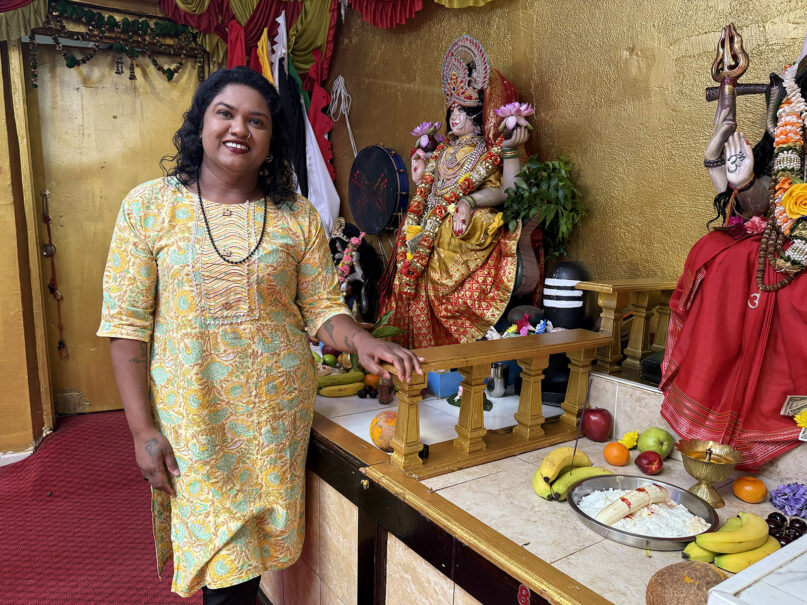
Sharda Ramsami at the Shri Shakti Mariammaa temple, July 13, 2025, in New York’s Queens borough. (RNS photo/Richa Karmarkar)
Other temples, Ramsami said, would throw women out for menstruating or not allow women to approach the altar. “That’s just not something we believe in,” she said. “We worship a woman.”
“Even in mainstream Hinduism,” Kalu said, “there’s so much patriarchy. Women aren’t really given roles, and whenever they are, it’s just mediocre roles in the kitchen making prasadam (offerings). I was really given a platform here to become a priestess.”
Now, the temple is in danger of closing. Without more than $150,000 in necessary upgrades to the space, the landlord and the city will move to push the temple out.
“I think Mother had a plan for us all to be here, because our lives changed so much and in so many ways,” said Hilda Thamen, Ramsami’s aunt and another founder of the temple. “She did so much for us. So now what’s going on here is really sad. It’s really hurting us.”
Back in 2018, a noise complaint from a neighbor led to intervention from the city’s Department of Buildings, resulting in a small fine. In 2024, after another noise complaint by the same neighbor, the city determined the temple needed to legally register as a community space. To do so, said Ramsami, the building needs several costly improvements to electricity, plumbing, fire safety and accessibility.
But it is unclear whether these changes are viable in a building intended for manufacturing, not worship. Though renting another location for more money may eventually be possible, “if we move somewhere further, we lose some of our congregants,” said Ramsami. “A lot of older folks come here, and the bus stop is right down the block, so it’s just easy for them to walk here.”
The neighbor, who lives in a single-family home behind the temple, heard the loud bhajans, or devotional songs, and drums nine nights in a row during the holiday of Navratri, an homage to the goddess Durga. At the time, he told congregants he would “rather there be a bar” than a temple so close to his windows. The neighbor has denied the temple’s request to build an exit in the back, and has constructed a 12-foot fence in between them.
“He came once and he saw our logo painted on the gate and he said, ‘Oh, Diablo, Diablo meaning the devil,'” said Ramsami. “So it definitely stems from fear.”
Most Kali temples in the area are tucked away in basements or backyards. “If you look at the murti or an image of Ma Kali, she’s so different from other mothers,” said Kalu. “She’s dark, she’s disheveled, she’s naked. She has blood dripping from her tongue. And I think all of that makes people uncomfortable. Blood is kind of deemed inauspicious, and I think from fear it became so taboo.”
Even in Guyana, said Thamen, “you were afraid to say you go to a Kali temple, because people look at you different.”
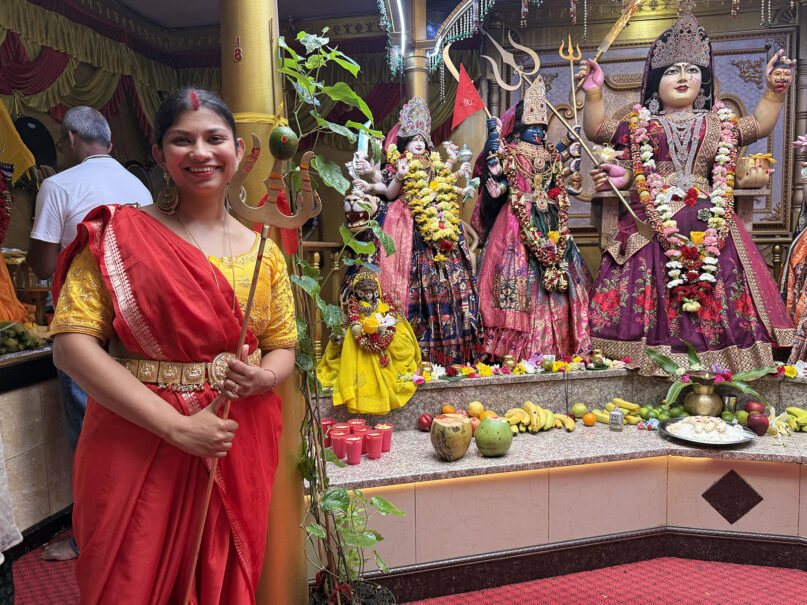
Chandni Kalu is a priestess at the Shri Shakti Mariammaa temple in Queens, N.Y. (RNS photo/Richa Karmarkar)
In the 19th century, the British brought scores of indentured Indians to Trinidad, Guyana and Suriname in the Caribbean. Many came from southern India and brought their animistic and folk religions with them. Caribbean Shaktism was thus born, with rituals passed down in a “broken” version of Tamil by word of mouth to the mostly English-speaking Indo-Caribbean population, with no Scriptures to consult and no book of mantras.
Yet the tradition still thrives thanks to the Queens temple’s founders, some of whose parents were priests in Shakti temples back in Guyana. A small group of second-generation New Yorkers gutted out the factory, built a kitchen and redid the roof, all while holding day jobs in commercial and residential cleaning, catering and nutrition school.
The mission of Shri Shakti Mariammaa was clear, said Dave Kutaiyah, the temple’s chairman. “This is not only a place for religion or a place where you come to pray on Sunday,” he said. “This is a place where you come and you see people who look like you, people who are familiar to you.
“That’s one of the things we instill in our temple: Treat everyone the same, whether you work for city government and you’re the right-hand person to the mayor, or you’re working at Dunkin’ Donuts on the 12 a.m. shift. People need to be loved and respected, and that’s what we try to bring here.”
The temple has survived through individual donations from families wanting a particular puja, or ritual, to be performed. But Kutaiyah and his team, even during the current financial struggle, have never asked for money from the congregation, or passed out a tithing plate.
“We believe worship should be free, health should be free, and we shouldn’t gain financially from that,” said Ramsami.
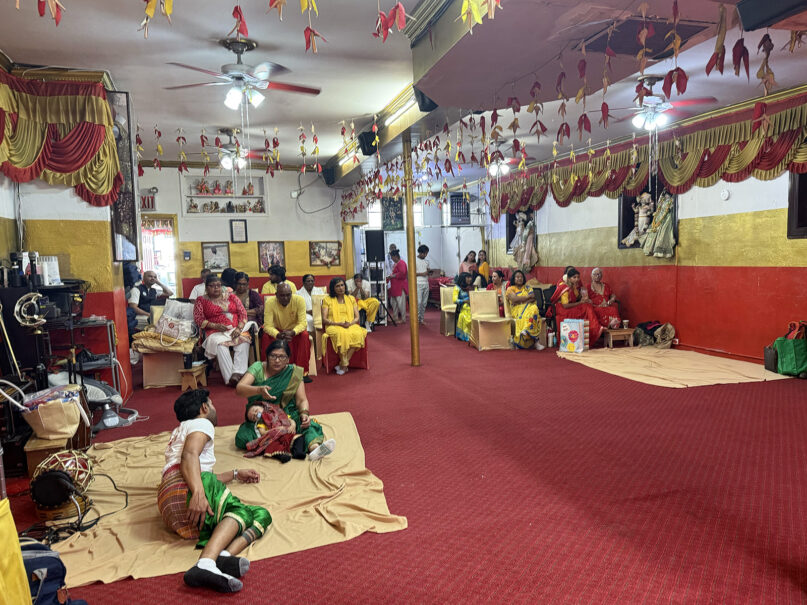
Congregants attend a worship service at the Shri Shakti Mariammaa temple, July 13, 2025, in Queens, N.Y. (RNS photo/Richa Karmarkar)
“I think 90% of people who attend here will tell you they work in a department store, factory or at JFK (International Airport), so we don’t have a lot of white-collar professionals that have a lot of disposable income to donate,” added Kutaiyah, who works in human resources. “I always tell people, use your pension money to pay your bills first, and then think about God. God will not be upset with you if you can’t give anything.”
A GoFundMe campaign, co-signed by a number of organizations that have used the temple’s space for meetings, such as Jahajee: Indo-Caribbeans for Gender Justice and the Caribbean Equality Project, has been circulating since June. In November, at a court date to pay an outstanding fine, the temple will ask the city for an extension to figure out its next steps.
Rohan Narine, NYC organizer with the national organization Hindus for Human Rights, one of the supporters of the GoFundMe campaign, has a personal stake in the temple’s success. A Queens native, Narine has been hosting Om Night open mics at the temple for years.
Narine considers himself an “orthodox Hindu” and was surprised on his first visit to see worshippers throwing menthol cubes of fire into their mouths and dousing themselves in rose water. But despite theological differences, “I felt that beauty and that raw spiritual energy that you don’t feel in other temples,” he said. “It’s not like sitting down at an ashram, offering prasad, do a little aarti (lamp ritual) and you eat and go home. Here, it’s very involved. It’s almost like being part of a live interactive performance.”
In Indo-Caribbean spaces in Queens, according to Narine, the temple’s style of worship is becoming more mainstream. More people are coming to the temple not just for curiosity’s sake, but to worship alongside the Shakti community.
“I think the entire expanse of Hinduism should be represented,” said Narine. “All of the Hindu pantheon should have the ability to practice their faith freely. We as Hindus, and especially Indo-Caribbean in America, are very comfortable with the more simplistic way of worship, and Shakti worship might be more complex. But we can’t shy away from that. I think we should be more open to that.”
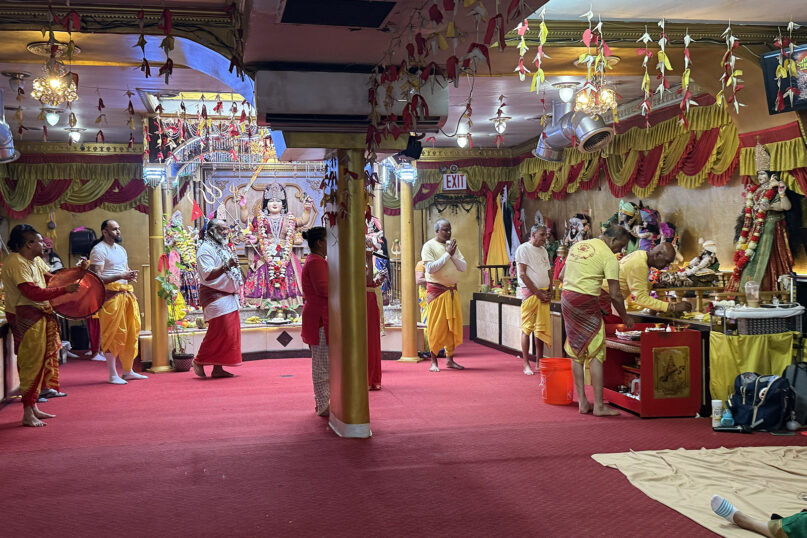
Congregants perform devotional rituals during a worship service at the Shri Shakti Mariammaa temple, July 13, 2025, in the Queens borough of New York. (RNS photo/Richa Karmarkar)

